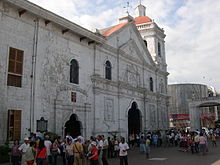Basilica del Santo Niño
The Basilica del Santo Niño in Cebu City ( Philippines ) was built on the site where the wooden statue of Santo Niño was found in 1565 . This figure was given on April 14, 1521 by Ferdinand Magellan after his arrival on the island of Cebu to Hara Humamay, the wife of the ruler Raja Humabon, because the couple and many subjects were baptized. Shortly thereafter, Magellan died in a battle on the neighboring island of Mactan . 44 years later, Miguel López de Legazpi recaptured the island. Since the inhabitants of Cebu were hostile to him, he had their settlement burned down in order to build the first Spanish settlements with the names Villa del Santísimo Nombre de Jesús (village in the holy name of Jesus) and Villa de San Miguel (village of St. Michael) . The sculpture was found almost intact after the fire in a scorched wooden box.
Immediately after arriving in Cebu in April 1565 of the traveling with Legazpi founded Andrés de Urdaneta , the Monastery of Santo Niño, the first Augustinian monastery in the Philippines. At the place where the wooden figure was found, the friar Diego de Herrera then built a church made of wood and nipa in 1566 , but this was soon destroyed by fire. In 1605, Pedro Torres began building a new church on the same site. This structure, again made of wood and nipa, was completed in 1626, but burned down as well two years later. In the same year, 1628, Juan Medina set about rebuilding the church. A kind of clay brick was now used as building material - a novelty at that time. However, the material used turned out to be unsuitable, as the clay bricks threatened to dissolve on contact with air and climatic influences, so that this third church could never be completed.
A good century later, in February 1735, the foundations for the basilica known today were finally laid. The massive stone building was completed in just four years in 1739. Natural stone was now used as building material, which was specially brought to Cebu by sea from quarries in Capiz and Panay . At that time the church was still called San Agustin Church . In 1889, windows were added to the building and in 1965 an extensive renovation took place, but the original structure from the 18th century was retained.
Four hundred years after Andrés de Urdaneta founded the Santo Niño Convent, the church was opened in 1965 by Pope Paul VI. for minor Basilica appointed. In the course of this, the name was also changed to Basilica minore del Santo Niño . In 1990 a pilgrimage center was built in the forecourt of the basilica. This uncovered construction offers space for up to 3500 pilgrims and its own museum is housed in its basement. The museum shows the history of the Christianization of the Philippines, which originated in Cebu. In addition to religious objects from the daily life of the adjacent convent, valuable pieces of jewelry such as rings and necklaces that have been donated by believers over the years are also on display in the museum.
The wooden statue of Santo Niños, once handed over to Hara Amihan by Magellan, has been preserved to this day and is kept inside the basilica, protected in a glass case, as a shrine. The sculpture is believed to be the oldest religious relic in the Philippines.
Web links
- Website about the Philippines: Santo Nino Pictures
- Cebuliving: Cebu's historical Basilica Minore del Sto. Niño (engl.)
Individual evidence
- ↑ a b Website of the Basilica del Santo Niño: Santo Niño Image ( Memento of August 24, 2010 in the Internet Archive )
- ↑ Jesus, dance with me! PHIILIPPINES On the island of Cebu, believers celebrate the miraculous salvation of their statue of the Redeemer. And yourself by Fritz Schaap and Patrick Witte, ZEIT January 12, 2012, C&W 5
- ^ Website of the Basilica del Santo Niño: Basilica Minore del Sto. Niño ( Memento from October 23, 2010 in the Internet Archive )
- ^ Giga-Catholic Information: Basilicas in Philippines
- ↑ APA Guides Philippines, ISBN 382681373-1 , p. 264
- ^ Website of the Basilica del Santo Niño: Pilgrim Center ( Memento of February 23, 2010 in the Internet Archive )
- ^ Website of the Basilica del Santo Niño: Museum ( Memento of February 23, 2010 in the Internet Archive )
Coordinates: 10 ° 17 ′ 38.5 ″ N , 123 ° 54 ′ 5.3 ″ E

